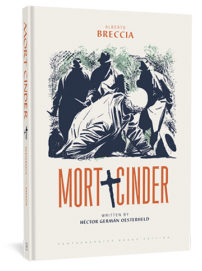 Héctor Germán Oesterheld
Héctor Germán Oesterheld
and Alberto Breccia
translated by Erica Mena
Fantagraphics ($29.99)
by John Pistelli
Mort Cinder is the first volume in The Alberto Breccia Library, a projected series that will present the legendary Argentine comics artist’s work to English-speaking audiences. The back cover of the book advertises Breccia as a forerunner of American creators celebrated for their dark and expressionistic styles: “Before Mike Mignola . . . Before Frank Miller . . . There was Breccia.” Originally serialized between 1962 and 1964 in the Argentine magazine Misterix, Mort Cinder combines horror, adventure, science fiction, and history to offer the perfect showcase for Breccia’s visual versatility.
The imposing title character, whose name evokes mortality and destruction, is paradoxically an immortal: he has died and returned again and again through history. The serial begins when this mysterious revenant teams up with English antiquarian Ezra Winston to evade Professor Angus, an evil genius who surgically turns ordinary people into “leaden-eyed men” that carry out his will.
This theme of thralldom carries over into the main action of the book. After they defeat Angus, Winston employs Cinder to help him catalogue antiquities, since the immortal has conveniently experienced all of history firsthand. Over eight episodes, Cinder recounts to Winston the hard times he’s spent on earth: He has been enslaved, imprisoned, or otherwise exploited by everyone from the king who tried to build the Tower of Babel to the twentieth-century American penal system. The serial’s diverse settings—the graveyard where the leaden-eyed men hunt Cinder, the trenches of the Great War, an Atlantic slave-ship, the battle of Thermopylae, and more—display the panoply of drawing styles Breccia commands.
Breccia’s multi-media black-and-white illustrations more than justify their preservation in a quality edition like this one, as opposed to the cheap newsprint on which they first appeared. On a single page, he can go from meticulously rendering Ezra Winston’s artifact-crammed room to violently slashing abstract bursts of light and fear.
In an afterword to this edition, Janis Breckenridge commends Breccia’s use of chiaroscuro to emphasize the story’s oneiric atmosphere and stark morality. She also discloses his inventive procedures—he employed “unorthodox tools (razor blades, toothbrushes, and more), materials (mixing ink with glues and solvents)”—before relaying his daughter’s testimony that the artist “would sometimes draw in a completely dark studio space lit only by candles in order the realistically capture the intense play of light and shadows.”
Despite this volume’s emphasis on Breccia’s Gothic artwork, the writer of Mort Cinder should not go unrecognized. The series was scripted by Héctor Germán Oesterheld, better known for his science-fiction masterpiece The Eternaut, which was published in English by Fantagraphics in 2015. Oesterheld was a life-long man of the political left who was “disappeared” by Argentina’s military dictatorship in 1977.
In the stories he tells to Winston, Cinder weaves his perennial experience of oppression into a global history seen from the viewpoint of the oppressed—a subtext that intimates Oesterheld’s hard-headed but humanistic and universalist political commitments. Oesterheld also bedecks his imaginative narrative with vivid, moving descriptions, well-captured in Erica Mena’s translation, that stress the pathos of humanity’s suffering. Here, for instance, Cinder narrates to Winston his poignant journey to a ruined African village with Wango, whom he helped escape from slavery:
Three days later, we went into the jungle. A jungle full of immense trees, a cathedral. We saw gorillas and made use of the path forged by a herd of elephants. We followed a great river. Days and days on the savannah until we finally arrived. The kraal razed by slave traders and vultures. The hunched sobbing of Wango.
Then Winston takes over the narration for a bittersweet, ironic conclusion to the story of “The Slave Ship”:
Mort fell silent, his gaze lost in another time, another place. From outside, on the street, came voices talking about soccer.
Mort Cinder is, among other things, a tale about how artifacts—the products of human ingenuity and labor—embody the individual and collective human experience we abstract as “history.” Our works testify to the future that we were here, that we suffered, and that we managed to create useful and beautiful things in spite of it all. This sturdy, well-made edition of a comic half a century old by creators who died decades ago takes its place among the enigmatic and enchanting antiquities that have the power to bring the past into the present and make it live again.
